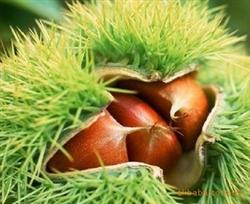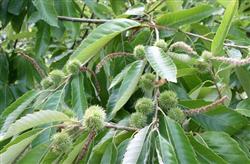What are the characteristics of chestnut trees?

What are the fertilizer characteristics of chestnut trees? Please introduce that Chinese chestnut is the same as other fruit trees in fertilizer demand, except that it needs sufficient nitrogen, phosphorus and potassium, but it is particularly sensitive to medium element magnesium and a small amount of manganese and boron. If lacking or insufficient, serious physiological obstacles will occur and affect growth and development. According to the determination, Chinese chestnut is a fruit tree with high manganese demand. The content of manganese in the leaves with normal growth and development is 1000mur2500mg / kg. If it is less than 1000 mg / kg, the leaves will be yellowed and the growth will be hindered. If there is a lack of magnesium or insufficient supply, there will be yellowing between the veins, and the discolored part will gradually turn brown and die. Because boron is an important element in promoting pollen germination, pollen tube growth and ovary development, soil boron deficiency will lead to empty buds. According to the survey, the results of the chestnut orchard with a soil available boron content of 0.56 mi / kg and 0.87 mg / kg were normal, and the empty bract rate was only 3% Mel 6.9%. The yield of the chestnut orchard with a content of 0.2 Mel 0.4 mg / kg was very low, and the empty bract rate was as high as 44% Mui 81%. The root was continued in Meiyuan Village, Dongling Township, Jianchuan County. when planting Chinese chestnut, 100 grams of boron sand was added to the base fertilizer, and 350 times borax water was sprayed once a year after planting, which was two years earlier than that without boron application and boron spraying. The demand for nitrogen, phosphorus and potassium is large, and the absorption period is different. The amount of nitrogen absorbed was large and lasted for a long time, and it was continuously absorbed from the beginning of bud germination to before fruit harvest, and the absorption was the most in the period of rapid expansion of fruit, which decreased gradually after harvest. The absorption time of phosphorus is stable from after flowering to before harvest, but the absorption amount is less, and the absorption time is shorter than that of nitrogen and potassium. However, phosphorus is very important to the fruiting performance and yield of Castanea mollissima. According to the determination, the content of available phosphorus in the soil of high-yield tree orchard is as high as 20.18k / kg, and the content of phosphorus in new shoots is 2420 mg / kg. The content of soil phosphorus in low-yield orchard is only 1ml / kg, and the content of phosphorus in new shoots is as low as 1360 mg / kg, which shows that phosphorus plays an important role in high and low yield. Phosphorus is an important substance to promote flower bud differentiation, fruit development, seed ripening and quality. Potassium was absorbed in a small amount before flowering, increased gradually after flowering, was absorbed the most in the fruit hypertrophy period, and decreased sharply after harvest. It is proved that in the annual growth cycle, from the differentiation of male flowers in early spring to flowering and fruit setting, nitrogen is the most, followed by potassium, and phosphorus is less; from flowering to fruit expansion, phosphorus is the most, followed by nitrogen and potassium; from fruit fat stage to harvest, potassium is the most, followed by nitrogen, and phosphorus is less. Click to get more chestnut planting techniques click to get more fruit planting techniques
- Prev

How to prevent the empty canopy of Chinese chestnut?
How to prevent the empty canopy of Chinese chestnut? Please introduce the method to cause the empty canopy of Chinese chestnut, in addition to the characteristics of the variety, the main reason is lack of nutrition or lack of boron. The comprehensive control measures are as follows: 1. Improved varieties: improve the varieties of poor chestnut trees with high empty canopy rate and low yield in mountainous areas. ...
- Next

How can chestnut trees be planted for high yield?
How can chestnut trees be planted for high yield? Please give an introduction to planting chestnut trees in order to obtain high yield, you can refer to the following cultivation models: first, select improved varieties. The improvement of chestnut cultivation is the basis for achieving high yield in a large area. The basic basis for the selection of improved varieties of Chinese chestnut is that ① has strong adaptability to local climate and soil conditions.
Related
- Moge, come on! The staff of the peasant association in the producing area of cantaloupe were frightened when the crowd gathered.
- Causes and Solutions of low Fruit setting rate of Apple
- Symptoms and control measures of passion fruit virus disease
- Fruit growing lesson: how do apple orchards keep high yields?
- Can you build orchards in the mountains? What are the pros and cons?
- How to manage the coloring period of Crisson grape?
- This paper introduces the processing technology of two kinds of fig products.
- How much is a month for retired teachers in rural areas by 2020?
- How can strawberry planting increase sugar content? We should pay attention to management in many aspects.
- What are the cultivation techniques on how to improve the yield of golden fruit?

